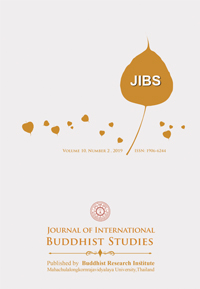A Three Dimensional Mandala in Pule Temple (Chengde, China) and an Emperor’s Tantric Buddhist Belief
Keywords:
mandala, Pule temple, chengdeAbstract
Pule Temple, one of a series of temples under the patronage of the Qing court (1644–1911), is unique in holding a giant, three-dimensional mandala as the only object in the main hall, distinguishing this temple from all others in China. This mandala is identified as a cakrasamvaraTantric Buddhist mandala, a visualized deity system and aid for initiation rituals and meditation. This study introduces the mandala in Pule Temple. The analysis on the key characteristics of the mandala and it peripheral visual context illustrates that, on the one hand, the Qing court attempted to manipulate Tibetan Buddhism to pacify both the Mongolian and the Tibetan communities. On the other hand, it is also a proof of the religious beliefs of Emperor Qianlong, who kept his devotion to Tibetan Buddhism rather private. The indicative elements in Pule temple, including the location, layout, decoration, and the inscriptions on the stele, illustrate the fusion of Confucianism, Daoism, and Buddhism in the mind of the Manchu ruler.
References
An, H. (2015). A Study on the Background of the Compilation of the Samadhi of Completion Exclusively Used by Qianlong (乾隆帝御用 藏密瑜伽修行宝典〈究竟定〉编译背景考). Journals on the Studies of Inner Asian Languages and History (西域历史语言研究集刊), 8,Beijing.
Architectural Department of Tianjin University. (1982). Ancient Architec ture in Chengde (承德古建築). Beijing: China Architecture & Building Press.
Berger, P. A. (2003). Empire of Emptiness: Buddhist Art and Political Authority in Qing China. Honolulu: University of Hawaii Press.
Buswell, R. E., & Lopez, D. S. (2013). The Princeton Dictionary of Buddhism. Princeton: Princeton University Press.
Forêt, P. (2000). Mapping Chengde: The Qing Landscape Enterprise. University of Hawaii Press.
Gou, A., & Wang, J. (2010). The development of roof color in ancient China. Color Research & Application, 35(4), 246–266. https:// doi.org/10.1002/col.20564
Hedin, S. A. (1933). Jehol, City of Emperors. Boston: E. P. Dutton & company, inc.
Huntington, J. C., & Bangdel, D. (2003). The Circle of Bliss: Buddhist Meditational Art. Chicago: Serindia Publications, Inc.
Li, J. (2008a). A Intoduction of Mandalas in Halls of Waibamiao (简述外 八庙殿堂内的曼陀罗). Chengde: Journal of Hebei Tourism Vocational College, (2), 158–160. Retrieved from http://www. cnki.net/KCMS/detail/detail.aspx?QueryID=2&CurRec=1&recid =&filename=CDZJ200802063&dbname=CJFD2008&dbcode=CJ FQ&pr=&urlid=&yx=&v=MjAxNTlBSmluUlpMRzRIdG5Nclk5 RFo0UjhlWDFMdXhZUzdEaDFUM3FUcldNMUZy Q1VSTHlmWXVkb0Zpam1XN3Y=
Li, J. (2008b). An Introduction of Mandalas in Halls of Waibamiao (简 述外八庙殿堂内的曼陀罗). Chengde: Journal of Hebei Tourism Vocational College, (2), 158–160. Retrieved from http://www. cnki.net/KCMS/detail/detail.aspx?QueryID=2&CurRec=1&recid =&filename=CDZJ200802063&dbname=CJFD2008&dbcode=CJ FQ&pr=&urlid=&yx=&v=MjAxNTlBSmluUlpMRzRIdG5Nclk5 RFo0UjhlWDFMdXhZUzdEaDFUM3FUcldNMUZy Q1VSTHlmWXVkb0Zpam1XN3Y=
Li, K. (1984). The Architecture and Tantric Philosophy of Pule Temple (普乐寺的建筑艺术及其密宗哲学). Beijing: Tibetan Studies (西藏研究), (2), 97–105.
Lo, C. (2012). A Study on Emperor Qianlong and the Meaning of Build ing the Fenhua Lou. Taipei: Mongolian & Tibetan Quarterly, 21(2).
Lo, C. C. (2008). Study of Emperor Qianlong as Manjusri Bodhisattva. Journal of China Institute of Technology, 38(6).
Luo, W. (2005). Dragon Robe and Kāṣāya: An Investigation on the Tibetan Buddhist Culture in Qing Court=龙袍与袈裟: 清宮藏传佛教文化考察. Beijing: Forbidden City Press.
Qianlong. (1776). On the Stele of Pule Temple.
Samuel, G. (2012). Introducing Tibetan Buddhism (1 edition). Routledge.
Shi, L., & Kooij, K. R. van. (2003). Pule Temple Chengde (承德普乐寺). Beijing: China Travel & Tourism Press.
thu’u bkyan blo. (2007). The Biography of Changkya Rolpe Dorje = 章嘉 若必多吉国师传. Beijing: China Tibetology Press.
Wang, X. (2000). The Qing Court’s Tibet Connection: Lcang skya Rol pa’i rdo rje and the Qianlong Emperor. 60(1). Cambridge: Harvard Journal of Asiatic Studies,), 125–163. https://doi. org/10.2307/2652702
Wang, Z. (2006). A Study on Qianlong’s Buddhist Initiation Location as Zhongzheng Palace (乾隆于中正殿灌顶考). The Source of Dharma (Fa Yuan), 24, 296–304.







